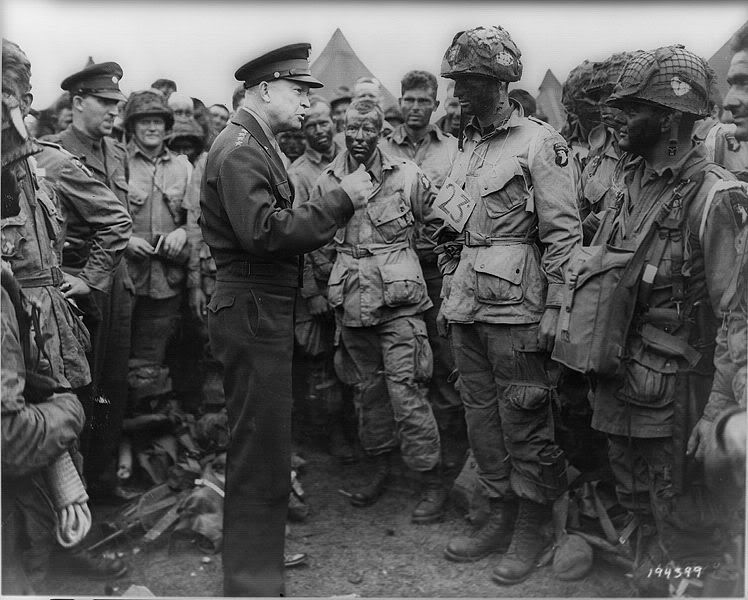
After the Japanese attack on Pearl Harbor, Eisenhower was assigned to the General Staff in Washington, where he served until June 1942 with responsibility for creating the major war plans to defeat Japan and Germany. He was appointed Deputy Chief in charge of Pacific Defenses under the Chief of War Plans Division, General Leonard T. Gerow, and then succeeded Gerow as Chief of the War Plans Division. Then he was appointed Assistant Chief of Staff in charge of Operations Division under Chief of Staff General George C. Marshall. It was his close association with Marshall that finally brought Eisenhower to senior command positions. Marshall recognized his great organizational and administrative abilities.
In 1942, Eisenhower was appointed Commanding General, European Theater of Operations (ETOUSA) and was based in London. In November, he was also appointed Supreme Commander Allied (Expeditionary) Force of the North African Theater of Operations (NATOUSA) through the new operational Headquarters A(E)FHQ. The word "expeditionary" was dropped soon after his appointment for security reasons. In February 1943, his authority was extended as commander of AFHQ across the Mediterranean basin to include the British 8th Army, commanded by General Bernard Law Montgomery. The 8th Army had advanced across the Western Desert from the east and was ready for the start of the Tunisia Campaign. Eisenhower gained his fourth star and gave up command of ETOUSA to be commander of NATOUSA. After the capitulation of Axis forces in North Africa, Eisenhower remained in command of the renamed Mediterranean Theater of Operations (MTO), keeping the operational title and continued in command of NATOUSA redesignated MTOUSA. In this position he oversaw the invasion of Sicily and the invasion of the Italian mainland.


In December 1943, it was announced that Eisenhower would be Supreme Allied Commander in Europe. In January 1944, he resumed command of ETOUSA and the following month was officially designated as the Supreme Allied Commander of the Allied Expeditionary Force (SHAEF), serving in a dual role until the end of hostilities in Europe in May 1945. In these positions he was charged with planning and carrying out the Allied assault on the coast of Normandy in June 1944 under the code name Operation Overlord, the liberation of western Europe and the invasion of Germany. A month after the Normandy D-Day landings on June 6, 1944, the invasion of southern France took place, and control of the forces which took part in the southern invasion passed from the AFHQ to the SHAEF. From then until the end of the War in Europe on May 8, 1945, Eisenhower through SHAEF had supreme command of all operational Allied forces2, and through his command of ETOUSA, administrative command of all U.S. forces, on the Western Front north of the Alps.
As recognition of his senior position in the Allied command, on December 20, 1944, he was promoted to General of the Army equivalent to the rank of Field Marshal in most European armies. In this and the previous high commands he held, Eisenhower showed his great talents for leadership and diplomacy. Although he had never seen action himself, he won the respect of front-line commanders. He dealt skillfully with difficult subordinates such as Omar Bradley and Patton, and allies such as Winston Churchill, Field Marshal Bernard Montgomery and General Charles de Gaulle. He had fundamental disagreements with Churchill and Montgomery over questions of strategy, but these rarely upset his relationships with them. He negotiated with Soviet Marshal Zhukov, and such was the confidence that President Franklin D. Roosevelt had in him, he sometimes worked directly with Stalin, much to the chagrin of the British High Command who disliked being bypassed. During the advance towards Berlin, he was notified by General Bradley that Allied forces would suffer an estimated 100,000 casualties before taking the city. The Soviet Army sustained 80,000 casualties during the fighting in and around Berlin, the last large number of casualties suffered in the war against Nazism.[21]
It was never certain that Operation Overlord would succeed. The seriousness surrounding the entire decision, including the timing and the location of the Normandy invasion, might be summarized by a second shorter speech that Eisenhower wrote in advance, in case he needed it. In it, he states he would take full responsibility for catastrophic failure, should that be the final result. Long after the successful landings on D-Day and the BBC broadcast of Eisenhower's brief speech concerning them, the never-used second speech was found in a shirt pocket by an aide. It read:
"Our landings in the Cherbourg-Havre area have failed to gain a satisfactory foothold and I have withdrawn the troops. My decision to attack at this time and place was based on the best information available. The troops, the air and the Navy did all that bravery and devotion to duty could do. If any blame or fault attaches to the attempt, it is mine alone."







No comments:
Post a Comment